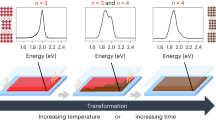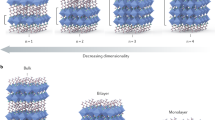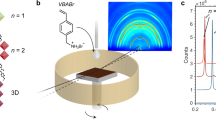Abstract
Due to their layered structure, two-dimensional Ruddlesden–Popper perovskites (RPPs), composed of multiple organic/inorganic quantum wells, can in principle be exfoliated down to few and single layers. These molecularly thin layers are expected to present unique properties with respect to the bulk counterpart, due to increased lattice deformations caused by interface strain. Here, we have synthesized centimetre-sized, pure-phase single-crystal RPP perovskites (CH3(CH2)3NH3)2(CH3NH3)n−1PbnI3n+1 (n = 1–4) from which single quantum well layers have been exfoliated. We observed a reversible shift in excitonic energies induced by laser annealing on exfoliated layers encapsulated by hexagonal boron nitride. Moreover, a highly efficient photodetector was fabricated using a molecularly thin n = 4 RPP crystal, showing a photogain of 105 and an internal quantum efficiency of ~34%. Our results suggest that, thanks to their dynamic structure, atomically thin perovskites enable an additional degree of control for the bandgap engineering of these materials
This is a preview of subscription content, access via your institution
Access options
Access Nature and 54 other Nature Portfolio journals
Get Nature+, our best-value online-access subscription
$29.99 / 30 days
cancel any time
Subscribe to this journal
Receive 12 print issues and online access
$259.00 per year
only $21.58 per issue
Buy this article
- Purchase on Springer Link
- Instant access to full article PDF
Prices may be subject to local taxes which are calculated during checkout





Similar content being viewed by others
Data availability
The data supporting the findings of this study are available within the Article and its Supplementary Information or from the authors.
References
Novoselov, K., Mishchenko, A., Carvalho, A. & Neto, A. C. 2D materials and van der Waals heterostructures. Science 353, aac9439 (2016).
Stoumpos, C. C. et al. Ruddlesden–Popper hybrid lead iodide perovskite 2D homologous semiconductors. Chem. Mater. 28, 2852–2867 (2016).
Mitzi, D. B., Feild, C. A., Harrison, W. T. A. & Guloy, A. M. Conducting tin halides with a layered organic-based perovskite structure. Nature 369, 467–469 (1994).
Ishihara, T., Takahashi, J. & Goto, T. Optical properties due to electronic transitions in two-dimensional semiconductors (CnH2n+1NH3)PbI4. Phys. Rev. B 42, 11099–11107 (1990).
Tanaka, K. et al. Electronic and excitonic structures of inorganic-organic perovskite-type quantum-well crystal (C4H9NH3)2PbBr4. Jpn J. Appl. Phys. 44, 5923–5932 (2005).
Saparov, B. & Mitzi, D. B. Organic–inorganic perovskites: structural versatility for functional materials design. Chem. Rev. 116, 4558–4596 (2016).
Shi, E. et al. Two-dimensional halide perovskite nanomaterials and heterostructures. Chem. Soc. Rev. 47, 6046–6072 (2018).
Tsai, H. et al. High-efficiency two-dimensional Ruddlesden–Popper perovskite solar cells. Nature 536, 312–316 (2016).
Blancon, J.-C. et al. Extremely efficient internal exciton dissociation through edge states in layered 2D perovskites. Science 355, 1288–1292 (2017).
Quan, L. N. et al. Tailoring the energy landscape in quasi-2D halide perovskites enables efficient green-light emission. Nano Lett. 17, 3701–3709 (2017).
Yuan, M. J. et al. Perovskite energy funnels for efficient light-emitting diodes. Nat. Nanotech. 11, 872–877 (2016).
Dou, L. et al. Atomically thin two-dimensional organic–inorganic hybrid perovskites. Science 349, 1518–1521 (2015).
Niu, W., Eiden, A., Prakash, G. V. & Baumberg, J. Exfoliation of self-assembled 2D organic–inorganic perovskite semiconductors. Appl. Phys. Lett. 104, 171111 (2014).
Yaffe, O. et al. Excitons in ultrathin organic–inorganic perovskite crystals. Phys. Rev. B 92, 045414 (2015).
Mitzi, D. B. in Progress in Inorganic Chemistry Vol. 48 (ed. Karlin, K.) 1–121 (Wiley, New York, NY, 1999).
Jaffe, A. et al. High-pressure single-crystal structures of 3D lead-halide hybrid perovskites and pressure effects on their electronic and optical properties. ACS Cent. Sci. 2, 201–209 (2016).
Kong, L. P. et al. Simultaneous band-gap narrowing and carrier-lifetime prolongation of organic–inorganic trihalide perovskites. Proc. Natl Acad. Sci. USA 113, 8910–8915 (2016).
Xiao, G. J. et al. Pressure effects on structure and optical properties in cesium lead bromide perovskite nanocrystals. J. Am. Chem. Soc. 139, 10087–10094 (2017).
Kubota, Y., Watanabe, K., Tsuda, O. & Taniguchi, T. Deep ultraviolet light-emitting hexagonal boron nitride synthesized at atmospheric pressure. Science 317, 932–934 (2007).
Cheng, H.-C. et al. Van der Waals heterojunction devices based on organohalide perovskites and two-dimensional materials. Nano. Lett. 16, 367–373 (2016).
Wu, X. X. et al. Trap states in lead iodide perovskites. J. Am. Chem. Soc. 135, 2089–2096 (2015).
Stébé, B., Assaid, E., Le Goff, S. & Dujardin, F. Giant oscillator strengths of ionized donor bound excitons in semiconductor quantum crystallites. Solid State Commun. 100, 217–220 (1996).
Dong, R. et al. High-gain and low-driving-voltage photodetectors based on organolead triiodide perovskties. Adv. Mater. 27, 1912–1918 (2015).
Kresse, G. & Hafner, J. Ab initio molecular dynamics for liquid metals. Phys. Rev. B 47, 558–561 (1993).
Yin, Z. Y. et al. Single-layer MoS2 phototransistors. ACS Nano 6, 74–80 (2012).
Wang, X. D. et al. Ultrasensitive and broadband MoS2 photodetector driven by ferroelectrics. Adv. Mater. 27, 6575–6581 (2015).
Furchi, M. M., Polyushkin, D. K., Pospischil, A. & Mueller, T. Mechanisms of photoconductivity in atomically thin MoS2. Nano. Lett. 135, 2089–2096 (2015).
Tan, Z. J. et al. Two-dimensional (C4H9NH3)2PbBr4 perovskite crystals for high-performance photodetector. J. Am. Chem. Soc. 138, 16612–16615 (2016).
Dou, L. et al. Solution-processed hybrid perovskite photodetectors with high detectivity. Nat. Commun. 5, 5404 (2014).
Guo, Q. S. et al. Black phosphorus mid-infrared photodetectors with high gain. Nano. Lett. 16, 4648–4655 (2016).
Sheldrick, G. M. Crystal structure refinement with SHELXL. Acta Crystallogr. Section C 71, 3–8 (2015).
Kresse, G. & Furthmüller, J. Efficient iterative schemes for ab initio total-energy calculations using a plane-wave basis set. Phys. Rev. B 54, 11169–11186 (1996).
Perdew, J. P. et al. Atoms, molecules, solids, and surfaces: applications of the generalized gradient approximation for exchange and correlation. Phys. Rev. B 46, 6671–6687 (1992).
Blöchl, P. E., Jepsen, O. & Andersen, O. K. Improved tetrahedron method for Brillouin-zone integrations. Phys. Rev. B 49, 16223–16233 (1994).
Grimme, S. Semiempirical GGA‐type density functional constructed with a long‐range dispersion correction. J. Comput. Chem. 27, 1787–1799 (2006).
Acknowledgements
K.L. thanks the Solar Energy Research Institute of Singapore (SERIS) for scholarship support. I.A. acknowledges the NUS–Imperial Joint PhD programme. K.P.L. acknowledges A* star DST funding under the project ‘Flexible and High Performance Based Perovskite Solar Cells on Graphene’ (no. R-143000-598-305). K.L. thanks I.-H. Park for help with solving single-crystal data, L. Wang for discussions of this work and H. Zhu for help with photoluminescence lifetime tests. G.E. acknowledges the Singapore Ministry of Education Tier 2 grant (MOE2015-T2-2-123).
Author information
Authors and Affiliations
Contributions
K.L. and K.P.L. conceived and designed the experiments. K.L. fabricated all RPP single crystals. K.L. and I.A. prepared all atomically thin samples and performed AFM measurements in the glove box. I.V. and K.L. tested the PC device. M.T. performed Q-plus nc-AFM scanning. K.L. and I.A. prepared samples for Q-plus nc-AFM scanning. K.L., L.Q.C. and I.A. performed photoluminescence measurements. I.A. and K.L. fabricated the devices. N.G. performed calculations. K.L. and K.P.L. wrote the manuscript. All authors contributed to the overall scientific interpretation.
Corresponding author
Ethics declarations
Competing interests
The authors declare no competing interests.
Additional information
Publisher’s note: Springer Nature remains neutral with regard to jurisdictional claims in published maps and institutional affiliations.
Supplementary information
Supplementary Information
Supplementary Text, Supplementary Figures 1–13, Supplementary Tables 1–8, Supplementary Reference 1
Rights and permissions
About this article
Cite this article
Leng, K., Abdelwahab, I., Verzhbitskiy, I. et al. Molecularly thin two-dimensional hybrid perovskites with tunable optoelectronic properties due to reversible surface relaxation. Nature Mater 17, 908–914 (2018). https://doi.org/10.1038/s41563-018-0164-8
Received:
Accepted:
Published:
Issue Date:
DOI: https://doi.org/10.1038/s41563-018-0164-8
This article is cited by
-
Boosting exciton mobility approaching Mott-Ioffe-Regel limit in Ruddlesden−Popper perovskites by anchoring the organic cation
Nature Communications (2024)
-
Growth of millimeter-sized 2D metal iodide crystals induced by ion-specific preference at water-air interfaces
Nature Communications (2024)
-
Pressure driven rotational isomerism in 2D hybrid perovskites
Nature Communications (2023)
-
Phase-pure two-dimensional layered perovskite thin films
Nature Reviews Materials (2023)
-
Colloid driven low supersaturation crystallization for atomically thin Bismuth halide perovskite
Nature Communications (2023)



